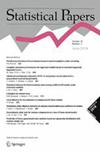具有非相同成分的序列阶次统计的多变量随机比较
IF 1.1
3区 数学
Q2 STATISTICS & PROBABILITY
引用次数: 0
摘要
序列有序统计(SOS)是建立系统寿命模型的有用工具,其中一个组件的失效会对其余存活组件的寿命产生重大影响。SOS 模型是一个通用模型,包含了大多数现有的有序随机变量模型。在本文中,我们考虑了具有非相同组件的 SOS 模型,然后讨论了单样本和双样本情况下的各种单变量和多变量随机比较结果。本文章由计算机程序翻译,如有差异,请以英文原文为准。

Multivariate stochastic comparisons of sequential order statistics with non-identical components
Sequential order statistics (SOS) are useful tools for modeling the lifetimes of systems wherein the failure of a component has a significant impact on the lifetimes of the remaining surviving components. The SOS model is a general model that contains most of the existing models for ordered random variables. In this paper, we consider the SOS model with non-identical components and then discuss various univariate and multivariate stochastic comparison results in both one-and two-sample scenarios.
求助全文
通过发布文献求助,成功后即可免费获取论文全文。
去求助
来源期刊

Statistical Papers
数学-统计学与概率论
CiteScore
2.80
自引率
7.70%
发文量
95
审稿时长
6-12 weeks
期刊介绍:
The journal Statistical Papers addresses itself to all persons and organizations that have to deal with statistical methods in their own field of work. It attempts to provide a forum for the presentation and critical assessment of statistical methods, in particular for the discussion of their methodological foundations as well as their potential applications. Methods that have broad applications will be preferred. However, special attention is given to those statistical methods which are relevant to the economic and social sciences. In addition to original research papers, readers will find survey articles, short notes, reports on statistical software, problem section, and book reviews.
 求助内容:
求助内容: 应助结果提醒方式:
应助结果提醒方式:


